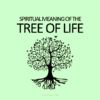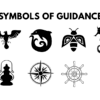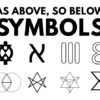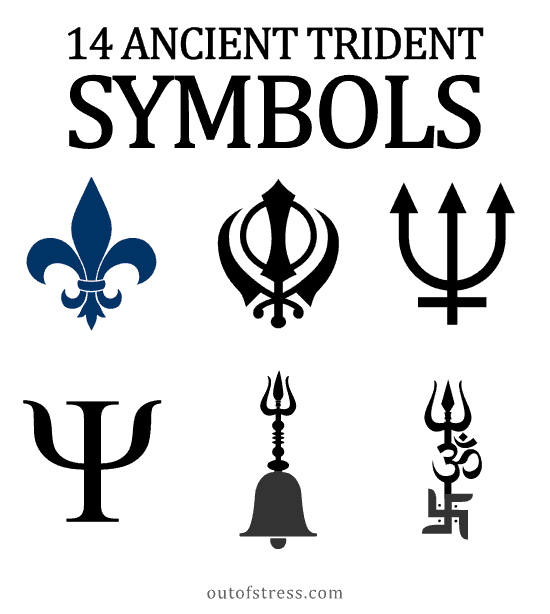
The trident, or trisula, is a three-pronged staff symbolizing great power across many traditions.
In Hinduism, it is Shiva’s weapon, representing transcendence, renewal, and higher consciousness. It also represents time’s three phases – past, present, and future and the realms of Heaven, Earth, and Hell.
In Greek and Roman mythology, Poseidon or Neptune uses it to rule the seas, making it a symbol of water and authority.
In Christian symbolism, it can represent the Cross, though it is also linked to Satan due to its pre-Christian origins.
The trident is further seen as a fire and lightning symbol, carried by several sky gods like Thor and Wotan, representing divine energy and transformation.
In this article, we’ll explore the deeper spiritual meaning of the trident and how you can use its energy in your own life to awaken higher awareness.
In the later part of this article, we’ll also look at 14 ancient trident symbols and uncover the unique meanings behind each one.
Let’s begin.
Spiritual Meaning of the Trident Symbol
1. Transcending Duality & Raising Consciousness
In Hinduism and other Yogic traditions, the trident known as the Trishula represents transcending duality and rising to higher states of consciousness.

It symbolizes the harmony between duality and unity. The two outer prongs represent the dual forces of existence, while the central prong, which is longer, represents the path of balance and singular awareness.
The central prong is longer because it shows the power that emerges when dualities are brought into harmony. When these two forces unite, true spiritual power awakens.
As per the Yogic Tradition, the human body has three subtle energy channels. The left channel, known as ida, carries lunar energy, and the right channel, known as pingala, carries solar energy. When these two energies unite in perfect balance, one enters the state of Sushumna, the most elevated level of consciousness. In this state, manifestation occurs, new insights arise, and the mind expands into higher awareness.
You reach this state through meditation, which is the act of moving into the center and bringing your conscious and unconscious states into balance. This is also why many Hindu deities are depicted with the trident symbol adorning their forehead.
Thus, the trident stands as a powerful symbol of meditation, creation, and higher consciousness. You can use this symbol in your meditation practice, and it will greatly help you deepen your focus and awareness.
2. Balance and Higher Wisdom
Continuing from the previous point, the trident encourages you to always seek balance in everything.
The left prong of the trident represents left-brain thinking, which is analytical and also linked to the egoic mind. The right prong represents right-brain thinking, which is imaginative, intuitive, and holistic. The central prong symbolizes the alignment of these two aspects of the mind.
When you bring them into balance, you are no longer ruled by ego and begin to transcend the illusion of duality, stepping into your higher nature.
Your third eye chakra begins to open, allowing you to become a channel for higher wisdom and guidance from the universe.
Thus, the trident is a powerful symbol of balance, harmony, higher thinking and wisdom.
3. Creation and Manifestation

Creation arises when masculine and feminine energies come together, and the trident represents this perfectly. The left and right prongs of the trident symbolize the Divine Feminine and Divine Masculine, while the central prong represents creation itself, which happens when these two energies are in perfect alignment.
The Divine Feminine is associated with imagination, intuition, rest, and receptivity, while the Divine Masculine is linked to action, logic, and focus. When these energies unite in harmony, the foundation of all creation is established.
Thus, the trident stands as a powerful symbol of creation and manifestation, and you can use it in your own life to bring your desired realities into being.
4. Trinetra (Three Eyes of Lord Shiva)

In Hinduism, the Trident (known as Trishula) also represents the Trinetra, or the three eyes of Lord Shiva.
- Shiva’s left eye symbolizes the Moon — the element of water and the realm of emotions.
- His right eye represents the Sun — the element of air, symbolizing thoughts, actions, and energy.
- His third eye, located at the center of his forehead, represents wisdom, intuition, enlightenment, and higher consciousness.
The third eye is associated with the element of fire and signifies the destruction of ego, desires, and ignorance, raising a person’s consciousness beyond the realm of duality.
This is why yogis and spiritual seekers often meditate by focusing their attention on the third eye, to awaken inner wisdom and divine perception.
5. Three States of Consciousness
The three prongs of the trident represent the three states of consciousness: the waking state (represented by the left prong), the dreaming state (represented by the right prong), and the state of deep awareness (represented by the central prong).
The third state is the most powerful of all. It is a state in which the mind is fully awake yet completely still. No thoughts arise here; you exist purely as conscious awareness, as a silent witness to all that is. In this state, all dualities dissolve, the egoic identity fades, and you merge with the infinite totality of existence.
During this state, you gain access to higher intelligence and divine insight. It can be reached through meditation, beginning with focused awareness on a single object such as your breath, allowing thoughts to pass without attachment, and then gently releasing all focus to rest in pure awareness itself.
The trident symbolizes meditation and the higher state of consciousness that every one of us has the potential to reach.
6. All of Time
The outer prongs of the trident represent your past and your future, while the central, longer prong represents the present moment. It reminds you that your true power exists only in the now.
Through meditation and mindfulness, you can anchor your awareness in the present, drawing strength and clarity from it.
As you stay rooted in this moment, you can learn from your past and envision your future without losing your connection to the power of the present.
7. Other Meanings
Besides the meanings already discussed, the trident carries the following significance in various cultures.
-
In Greek and Roman culture, the trident symbolizes sea power and authority, as it was used by Poseidon (or Neptune) to control the waters and storms.
- In Buddhism, the trident stands for the Three Jewels, Buddha, Dharma, and Sangha, signifying the path to spiritual liberation.
-
In Polynesian and Hawaiian traditions, it symbolizes oceanic strength, protection, and mastery over the sea.
-
In Mesopotamian culture, the trident represents divine authority and the link between heaven, earth, and the underworld.
-
In Celtic and Norse traditions, it signifies harmony with nature and control over elemental forces.
-
In Christian and esoteric symbolism, the trident reflects the Holy Trinity or hidden spiritual power.
-
In modern and popular culture, it is seen as a sign of strength, rebellion, and mastery over one’s world.
Now, let’s look at 14 powerful trident symbols from different cultures and the unique symbolism each carries.
14 Trident Symbols (from Around the World) & Their Deeper Symbolism
1. Trishul: Shiva & Durga’s Trident
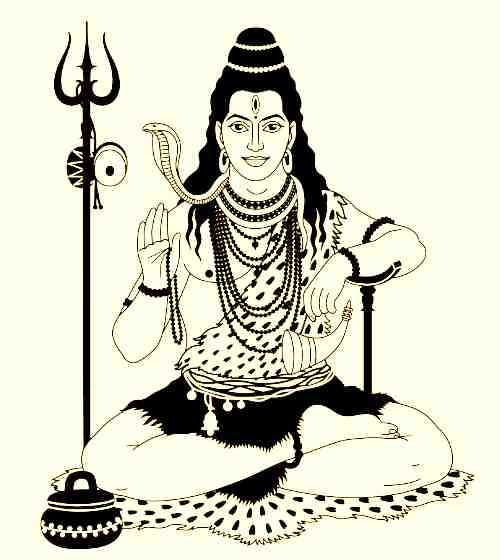
The Trishul is the Hindu trident. It is a powerful divine emblem focused on the clouds, sky, weather, and heavenly events. While many gods may carry or use a Trishul, this trident is especially important for Lord Shiva and Maa Durga. These powerful gods are rarely seen without a Trishul, and it is used to represent the various values, aspects, and abilities that they promote.
Here’s what Shiva’s and Durga’s Trident represent:
Control of Mind, Intellect, & Ego
Lord Shiva carries the Trishul as a weapon. But instead of fighting against outside forces, the Trishul is used to fight inner battles. It helps us gain control over the mind, intellect, and ego. As we grow spiritually, we eventually lose attachment to the meaningless things around us. We separate from the physical world of illusion, we destroy the mental pain of ego, and we settle at last into the spiritual realm of enlightenment.
Three Energy Channels
The Trishul also represents the three energy channels or Nadis that flow through us. The Ida is the passive feminine Nadi, while the Pingala is the active male Nadi. These energetic lines represent the dualities of the universe, personified by Shiva and Shakti. They pass through us from our feet all the way to the throat chakra, where the Sushumna Nadi joins them.
Sushumna is more significant than Ida and Pingala, as it represents the conjoined male and female energy. A balanced life begins as Sushumna emerges, and Shiva can help us unlock this energy to live in harmony.
Trinity
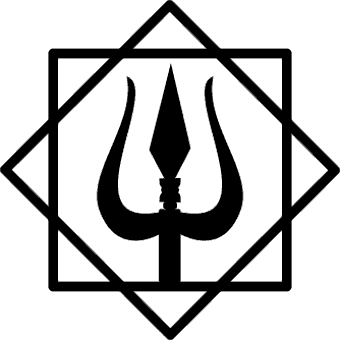
The three blades of the Trishul represent the Hindu holy trinity. This includes Lord Brahma, the Creator; Lord Vishnu, the Preserver; and Lord Shiva, the Destroyer. Here, the trident represents the balance of creation, preservation, and destruction.
In some cases, the trident also represents the Tridevi or female aspect of the Trinity. This includes Saraswati, Lakshmi, and Parvati. Additionally, the Trishul may be an elemental symbol connecting the trinities of the sea, earth, and sky or birth, life, and death.
Three States of Consciousness
The Trishul depicts the three aspects of human consciousness: waking, sleeping, and deep sleep states. It represents the fact that Lord Shiva is above these conscious states yet upholds and supports them all. He guides humans through and eventually past states of consciousness into the ultimate state of Nirvana.
Past, Present, & Future
The three prongs of the Trishul denote different periods in a person’s life and represent our past, present, and future. Holding the trident, Lord Shiva has ultimate control of the wheel of time. This is a joyous thing for those of faith, as Shiva promotes good deeds and removes problems from our timeline.
Destruction of Suffering
The word Trishul can be directly translated into two parts. “Tri,” meaning three, and “shul,” meaning pain. The three prongs represent the three types of pain: Aadibhautik (physical), Aadhyaatmik (spiritual), and Aadidaivik (ethereal). Lord Shiva uses the Trishul in a spiritual battle to destroy all three types of pain and eliminate other obstacles that get in the way of our happiness.
Three Agnis
The Trishul also represents the three types of Agni so intrinsic to ayurveda. The Agni is an inner fire that helps with the body’s physical processes.
- The first type is Jatharagni, the fire in our belly that fuels our digestion and metabolism.
- The second is Bhutagni, the fire in our liver that allows us to take in nutrients.
- The third is Dhatwagni, which works on a cellular level to utilize outside nutrients.
The balance of the three Agnis invokes the energy of spiritual growth, inner strength, and the ignition of divine fire within yourself.
Three Gunas
The Trishul is a powerful emblem of the three Gunas, or qualities that make up the universe.
- First is tamas, or stability.
- The second is rajas, or activity.
- The third is sattva, or consciousness.
The Gunas have distinct qualities, both positive and negative. Each Guna corresponds to how we comport ourselves and respond to a given situation. In the hands of Lord Shiva or Maa Durga, the Trishul represents the most positive aspects of the Gunas. These aspects represent a roadmap to our most ideal selves.
Three Powers
The Hindu trident represents the perfect coupling of the three humanistic powers—knowledge, will, and action. We can manipulate these powers when we know how to work with them. We can balance knowledge, will, and power by channeling Lord Shiva. In this sense, we use the metaphorical trident to achieve our goals.
Spiritual Protection
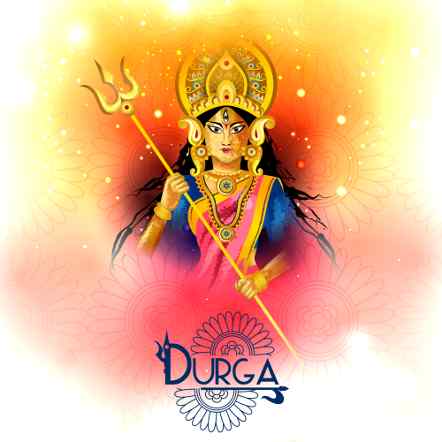
The Trishul protects us from spiritual evils on our journey to enlightenment. It represents our best qualities in each of its arms, helping us become better people by resisting temptation and thwarting negative influences. The Trishul removes the obstacles of our bad qualities, so we can get out of our own way and connect with the divine. Once connected, we can access the universe’s unlimited and positive power.
Triumph of Good Over Evil
The Trishul represents a metaphorical battle we fight daily against our bad qualities and the world’s injustices. It symbolizes our ability to triumph over evil in all forms, emerging from the fight victorious. It also reminds us that when we act with positive intentions, the world will become a better place overall.
2. Trishul with Damru
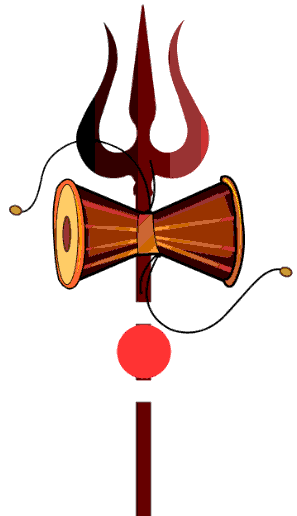 The Damru is a small drum that represents the cosmic sound from which the universe is created. Everything in existence is vibration.
The Damru is a small drum that represents the cosmic sound from which the universe is created. Everything in existence is vibration.
In the same way, the Damru also symbolizes the power of sound waves, mantras, and vibrational energy.
This symbolizes how much power your words, prayers, and mantras have. With sound, you create and connect to universal vibrations. You can summon the divine, raise your consciousness, and move forward with clarity and connection on your spiritual path.
3. Trishakti

This symbol combines the Trishul with the Om symbol and the Hindu swastika. These are three of the most powerful signs in Hindu practice, and putting them all together symbolizes the absolute power of god and the universe. When hung or drawn, the Trishakti can purify the air around it. It removes inauspicious thoughts and feelings to help you connect with the divine.
4. Trishul Bisa Yantra
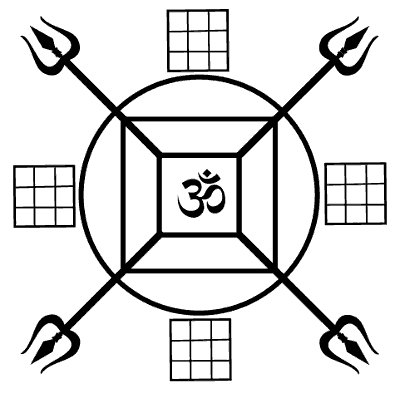
The Trishul Bisa Yantra is a powerful symbol attributed to Maa Durga. As a protective deity, Maa Durga shields her followers from disease, pain, and suffering. Those who hang the Trishul Bisa Yantra around their home will be blessed by Maa Durga and protected from evils. They may also achieve a higher consciousness, improved relationships, and increased financial wealth.
5. Taoist Trident
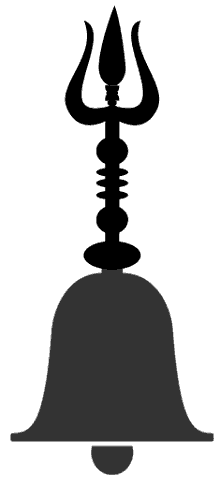
The Taoist trident symbolizes the holy trinity of deities in the Taoist religion: Yuanshi Tianzun, Lingbao Tianzun, and Daode Tianzun. These gods are the Sanquing, or the three Pure Ones. They represent essence, energy, and vitality. Similar to the holy trinities of Christianity or Buddhism, the three Pure Ones are different aspects of the same divine. Practitioners ring the Trident Bell in Taoist religious ceremonies to summon these divinities for worship and prayer.
6. Triratna

In Buddhism, the trident takes the form of the Triratna. This symbol represents the holy flame and three jewels of Buddhism—the Dharma, or teachings, the Sangha, or community of practitioners, and the Buddha himself. Using the three jewels along with the strength of the flame, we can defeat the poisons of greed, hatred, and delusion. In this way, we use the Triratna to live an upstanding and harmonious life.
7. Poseidon and Neptune’s Trident
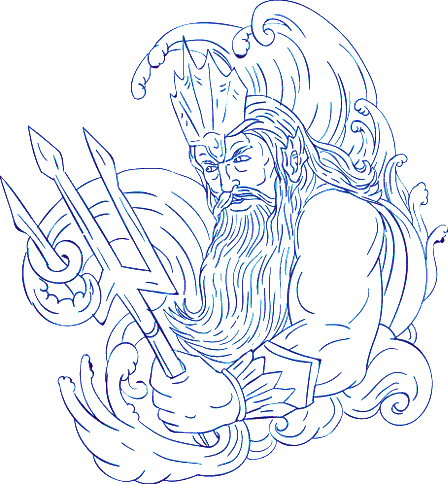
We often associate the trident with seas, oceans, and water. This is partly because it was used to symbolize the Roman sea-God Poseidon and his Greek counterpart Neptune. Its watery origins likely began with the classic fishing spear, a three-pronged instrument closely resembling the trident.

The spear provided sustenance and was vital to daily life. As it morphed into a godly weapon, it took on even more power and was said to control the seas, pierce the sky, and lead men to victory in naval battles.
Here’s what Poseidon’s and Neptune’s trident symbolizes:
Holy Trinity
With its three prongs, Poseidon’s trident represents the trinity of earth, sky, and water. These elements make up the very fabric of reality and impact us every day. It also denotes the three human stages of birth, life, and death. As the three prongs stem from one original line, the trident symbolizes how each stage is connected and reliant upon the others.
Higher Purpose
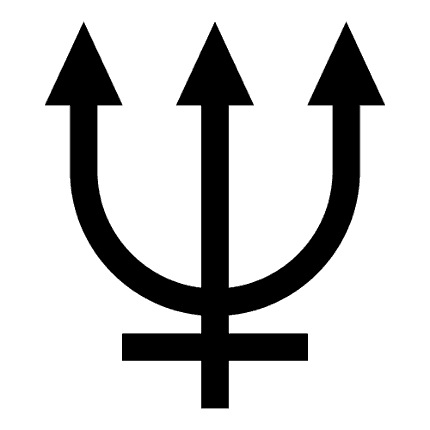
Neptune’s trident is astrologically connected to the planet Neptune and represents how humanity strives for a higher purpose. It rests on the cross of matter, yet its three spears reach upwards toward the spiritual plane. This trident is a receptive crescent, symbolic of our open-minded search for meaning, understanding, and enlightenment.
Transcendence
Neptune’s trident represents a connection between the physical and spiritual worlds. It is a symbol of hope for those on a spiritual journey, illustrating that the prize of transcendence is within our grasp.
8. Algiz Rune
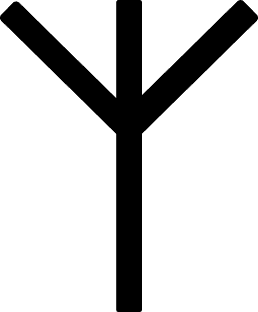
The Algiz rune is the ancient Norse rune of divine connection resembling a person with arms outstretched toward heaven. An esoteric symbol, the Algiz is used in divination, dreamwork, and protective magic. The Algiz rune represents our quest for understanding and gives protection as we fight our way through the physical world. It helps us learn without fear or prejudice and carries us safely to the afterlife when we die.
9. Helm of Awe

The Helm of Awe is a fearsome symbol consisting of eight arms radiating from a single circle. Each arm is a trident with three prongs. Some say that the arms are actually Algiz runes, which would make sense. The symbol itself resembles a protective barrier around the circle and was worn to defend and protect warriors in Viking battles.
10. Awen Symbol
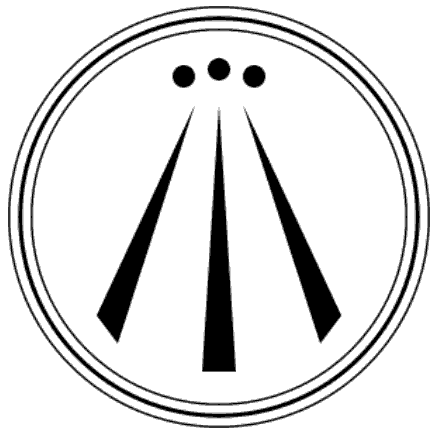
The Awen is a Celtic symbol featuring three rays of light extending from three points. It looks different from the traditional trident but still carries the motif. The Awen is an artistic symbol representing our abilities to inspire and be inspired. It nurtures our minds and fosters creativity in all of us.
The three prongs of the Awen symbol may stand for man, woman, and child. They may also stand for the three elements of earth, sea, and sky. These rays of light grow closer at the top to symbolize the connection between all three aspects, depicting how each one is intricately woven into the others.
11. Psi

The Psi is a Greek letter used to represent the psyche and the heart, mind, and soul that make us human. It is the symbol for the study of psychology and illustrates the interconnected nature of rational thought, physical desires, and spiritual aspects of humanity. It can also represent other fields of science, like physics or astronomy.
12. Trishul Mudra

The Trishul Mudra is a sacred hand symbol in Hinduism that involves joining the thumb and the little finger, with the thumb resting on top of the little finger’s nail. The other three fingers are extended outward, creating the shape of a trident.
This mudra holds significance as it is believed to alleviate fear, anxiety, and nervousness by balancing the fire and water elements within the body.
When practiced during meditation, the Trishul Mudra acts as a purifying force, helping to dissolve and release old beliefs and stagnant energies that hinder personal growth. To enhance its effects, perform this mudra with both hands while focusing on anything that obstructs your true potential. Allow the power of the mudra to clear your mind and pave the way for a more liberated path ahead.
13. Khanda

The Khanda is a sacred Sikh symbol that bears a resemblance to a trident. It comprises a central double-edged sword, representing divine knowledge, spiritual power, and righteousness.
Surrounding the central sword are two curved single-edged swords called “Kirpans.” These kirpans symbolize the concept of Miri and Piri, which represent the material and spiritual realms respectively. Miri signifies being grounded in the material world while striving to reach one’s true potential, while Piri represents the pursuit of spirituality while living in a material world. The two kirpans symbolize the need for balance between worldly and spiritual responsibilities.
At the center of the symbol is a circle known as the Chakkar, symbolizing the eternal nature of God and life.
14. Palmist Tridents
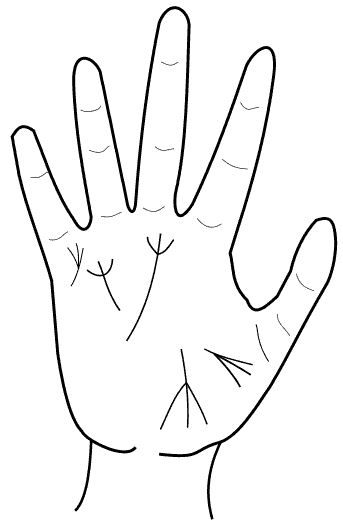
Palm readers may be able to spot a trident on your palm. The trident is simply three lines that stem from a single point. It can be located anywhere on your hand or even in multiple places. The palm trident represents good luck in its palm line. For example, if you have a trident over your heart line, you will experience trials and tribulations in love and family life. However, the trident also means you will overcome them to have a happy love life and healthy family relationships.
Conclusion
The trident is a symbol of strength, power, and compassion. It gives protection, nurtures goodness, and represents our quest for higher learning and understanding. A divine symbol, the trident connects us to the world beneath our feet and the universe around us. If you need to reclaim your power or spark passion, bring some of these trident symbols into your home today.


